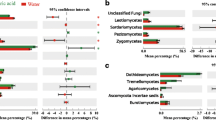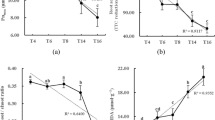Abstract
Experiments were conducted to determine whether changes in soil microbial populations that occur in response to additions of certain allelopathic phenolic acids to bulk soil also occur in the rhizosphere. Cucumber seedlings were transplanted into cups containing a nutrient-enriched mixture of Portsmouth B1, soil and sand and were watered five times (once every 48 hr) with aqueous solutions of ferulic,p-coumaric, or vanillic acid (each at 0, 0.25, or 0.50μol/g soil material). Nutrient solution was applied on alternate days. Leaf growth was suppressed by up to 42% by phenolic acids, but changes in root growth varied with the compound and concentration in solution. Significant increases (over 600% relative to controls) in populations of fast-growing bacteria in the rhizosphere were detected after two but not after five treatments, and increases (400% relative to controls) in numbers of fungal propagules were detected after five treatments. Such increases suggested that chronic exposure to a phenolic acid might resuit in high populations of rhizosphere microorganisms that could metabolize the compounds and thus alter observable responses by the plant. To test this, plants were watered repeatedly with a low-concentration solution of ferulic acid (chronic treatments; 0.0 or 0.1μmol/g soil material in one experiment, 0.000 or 0.025μimol/g soil material in a second) and then once with a highconcentration solution (acute treatment; 0.0, 0.5, or 1.0μmol/g soil material in the first experiment; 0.000, 0.125, or 0.250μmol/g soil material in the second).
Similar content being viewed by others
References
Balke, N.E. 1985. Effects of allelochemicals on mineral uptake and associated physiological processes, pp. 161–173,in A.C. Thompson (ed.). The Chemistry of Allelopathy. American Chemical Society Monograph saSeries 268. American Chemical Society, Washington, D.C.
Blum, U., andDalton, B.R. 1985. Effects of ferulic acid, an allelopathic compound, on leaf expansion of cucumber seedlings grown in nutrient culture.J. Chem. Ecol. 11:279–301.
Blum, U., andRebbeck, J. 1989. Inhibition and recovery of cucumber roots given multiple treatments of ferulic acid in nutrient culture.J. Chem. Ecol. 15:917–928.
Blum, U., andShafer, S.R. 1988. Microbial populations and phenolic acids in soil.Soil Biol. Biochem. 20:793–800.
Blum, U., Dalton, B.R., andRawlings, J.O. 1984. Effects of ferulic acid and some of its microbial metabolic products on radicle growth of cucumber.J. Chem. Ecol. 10:1169–1191.
Blum, U., Dalton, B.R., andShann, J.R. 1985. Effects of various mixtures of ferulic acid and some of its microbial metabolic products on cucumber leaf expansion and dry matter in nutrient culture.J. Chem. Ecol. 11:619–641.
Blum, U., Weed, S.B., andDalton, B.R. 1987. Influence of various soil factors on the effects of ferulic acid on leaf expansion of cucumber seedlings.Plant Soil 98:111–130.
Curl, E.A., andTruelove, B. 1986. The Rhizosphere. Springer-Verlag, Berlin.
Cutler, H.G. 1986. Isolating, characterizing, and screening mycotoxins for herbicidal activity, pp. 147–170,in A.R. Putnam and C.-S. Tang (eds.). Science of Allelopathy, Wiley-Interscience, New York.
Dagley, S. 1971. Catabolism of aromatic compounds by microorganisms, pp. 1–46,in A.H. Rose and J.F. Wilkinson (eds.). Advances in Microbial Physiology, Vol. 6. Academic Press, London.
Dalton, B.R., Blum, U., andWeed, S.B. 1983. Allelopathic substances in ecosystems: Effectiveness of sterile soil components in altering recovery of ferulic acid.J. Chem. Ecol. 9:1185–1201.
Del Moral, R., andMuller, C.H. 1970. The allelopathic effectsof Eucalyptus camaldulensis.Am. Midl. Nat. 83:254–282.
Einhellig, F.A., andEckrich, P.C. 1984. Interactions of temperature and ferulic acid stress on grain sorghum and soybeans.J. Chem. Ecol. 10:161–169.
Einhellig, F.A., Stille Muth, M., andSchon, M.K. 1985. Effects of allelochemicals on plant-water relationships, pp. 179–196,in A.C. Thompson (ed.). The Chemistry of Allelopathy. American Chemical Society Monograph Series 268. American Chemical Society, Washington, D.C.
Evans, W.C. 1963. The microbial degradation of aromatic compounds.J. Gen. Microbiol. 32:177–185.
Flaig, W. 1964. Effects of microorganisms in the transformation of lignin to humic substances.Geochem. Cosmochim. 28:1523–1533.
Greb, B.W., Black, A.L., andSmika, D.E. 1967. Effect of straw mulch rates on soil water storage during summer fallow in the Great Plains.Soil Sci. Soc. Am. Proc. 31:556–559.
Greb, B.W., Black, A.L., andSmika, D.E. 1974. Straw buildup in soil with stubble mulch fallow in the semiarid Great Plains.Soil. Sci. Soc. Am. Proc. 38:135–136.
Harris, R.F., andSommers, L.E. 1968. Plate-dilution frequency technique for assay of microbial ecology.Appl. Microbiol. 16:330–334.
Hoagland, R.E., andWilliams, R.D. 1985. The influence of secondary plant compounds on the association of soil microorganisms and plant roots, pp. 301–325,in A.C. Thompson (ed.). The Chemistry of Allelopathy. American Chemical Society Monograph Series 268. American Chemical Society, Washington, D.C.
Liebl, R.A., andWorsham, A.D. 1983. Inhibition of pitted morning glory (Ipomoea lacunosa L.) and certain other weed species by phytotoxic components of wheat (Triticum aestivum L.) straw.J. Chem. Ecol. 9:1027–1043.
Martin, J.P., andHaider, K. 1976. Decomposition of specifically carbon-14-labeled ferulic acid: Free and linked into humic acid-type polymers.Soil Sci. Soc. Am. J. 40:377–380.
Patterson, D.T. 1981. Effects of allelopathic chemicals on growth and physiological responses of soybean (Glycine max).Weed Sci. 29:53–59.
Putnam, A.R., andTang, C.-S. 1986. Science of Allelopathy. Wiley-Interscience, New York.
Rice, E.L. 1984. Allelopathy. Academic Press, Orlando.
SASInstitute 1988. SAS/STAT User's Guide: Release 6.03 Edition. SAS Institute Inc., Cary, North Carolina.
Schmidt, S.K. 1988. Degradation of juglone by soil bacteria.j. Chem. Ecol. 14:1561–1571.
Shafer, S.R. 1988. Influence of ozone and simulated acidic rain on microorganisms in the rhizosphere ofSorghum.Environ. Pollut. 51:131–152.
Sparung, G.P., Ord, B.G., andVaughan, D. 1981. Changes in microbial biomass and activity in soils amended with phenolic acids.Soil Biol. Biochem. 13:455–460.
Steel, R.G.D., andTorrie, J.H. 1980. Principles and Procedures of Statistics, 2nd ed. McGrawHill, New York. 633 pp.
Thelander, O. 1985. Review of straw carbohydrate research, pp. 217–230,in R.D. Hill and L. Munck (eds.). New Approaches to Research on Cereal Carbohydrates, Progress in Biotechnology, Vol. 1. Elsevier, New York.
Thompson, A.C. 1985. The Chemistry of Allelopathy: Biochemical Interactions among Plants. American Chemical Society Monograph Series 268. American Chemical Society, Washington, D.C.
Turner, J.A., andRice, E.L. 1975. Microbial decomposition of ferulic acid in soil.J. Chem. Ecol. 1:41–58.
Vaughan, D., Sparling, G.P., andOrd, B.G. 1983. Amelioration of the phytotoxicity of phenolic acids by some soil microbes.Soil Biol. Biochem. 15:613–614.
Wang, T.S.C., Yang, T., andChang, T. 1967. Some phenolic acids as plant growth inhibitors.Soil Sci. 103:239–246.
Williamson, G.B., andWeidenhamer, J.D. 1990. Bacterial degradation of juglone: Evidence against allelopathy?J. Chem. Ecol. 16:1739–1741.
Author information
Authors and Affiliations
Additional information
Paper No. 12385 of the Journal Series of the North Carolina Agricultural Research Service, Raleigh, North Carolina. The use of trade names in this publication does not imply endorsement by the North Carolina Agricultural Research Service or the United States Department of Agriculture of the products named, nor criticism of similar ones not mentioned. Acute treatments and some chronic treatments suppressed leaf growth, but results were inconsistent for root growth. Acute treatments increased numbers of several types of bacteria in the rhizosphere but had inconsistent effects on fungi. Chronic treatments had no effect on numbers of bacteria or fungal propagules in the rhizosphere. Furthermore, chronic treatments did not alter responses of plants or microbial populations to the subsequent acute treatment. Results demonstrated that phenolic acids in soil, which must pass through the rhizosphere before interaction with plant roots can occur, alter the microbial ecology of the rhizosphere. However, microbially mediated acclimation of plants to relatively high concentrations of ferulic acid was not observed.
Rights and permissions
About this article
Cite this article
Shafer, S.R., Blum, U. Influence of Phenolic acids on microbial populations in the rhizosphere of cucumber. J Chem Ecol 17, 369–389 (1991). https://doi.org/10.1007/BF00994339
Received:
Accepted:
Issue Date:
DOI: https://doi.org/10.1007/BF00994339




